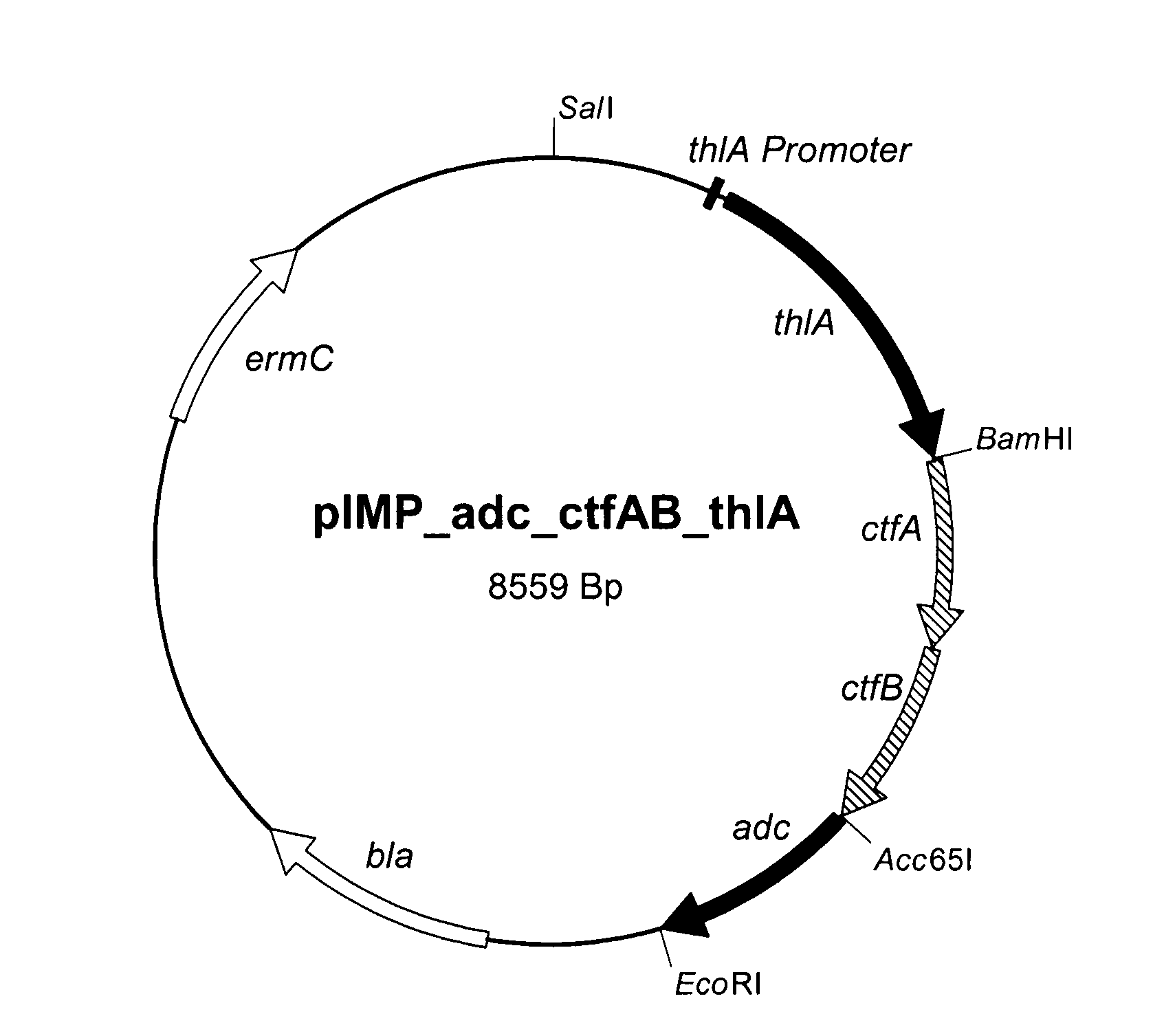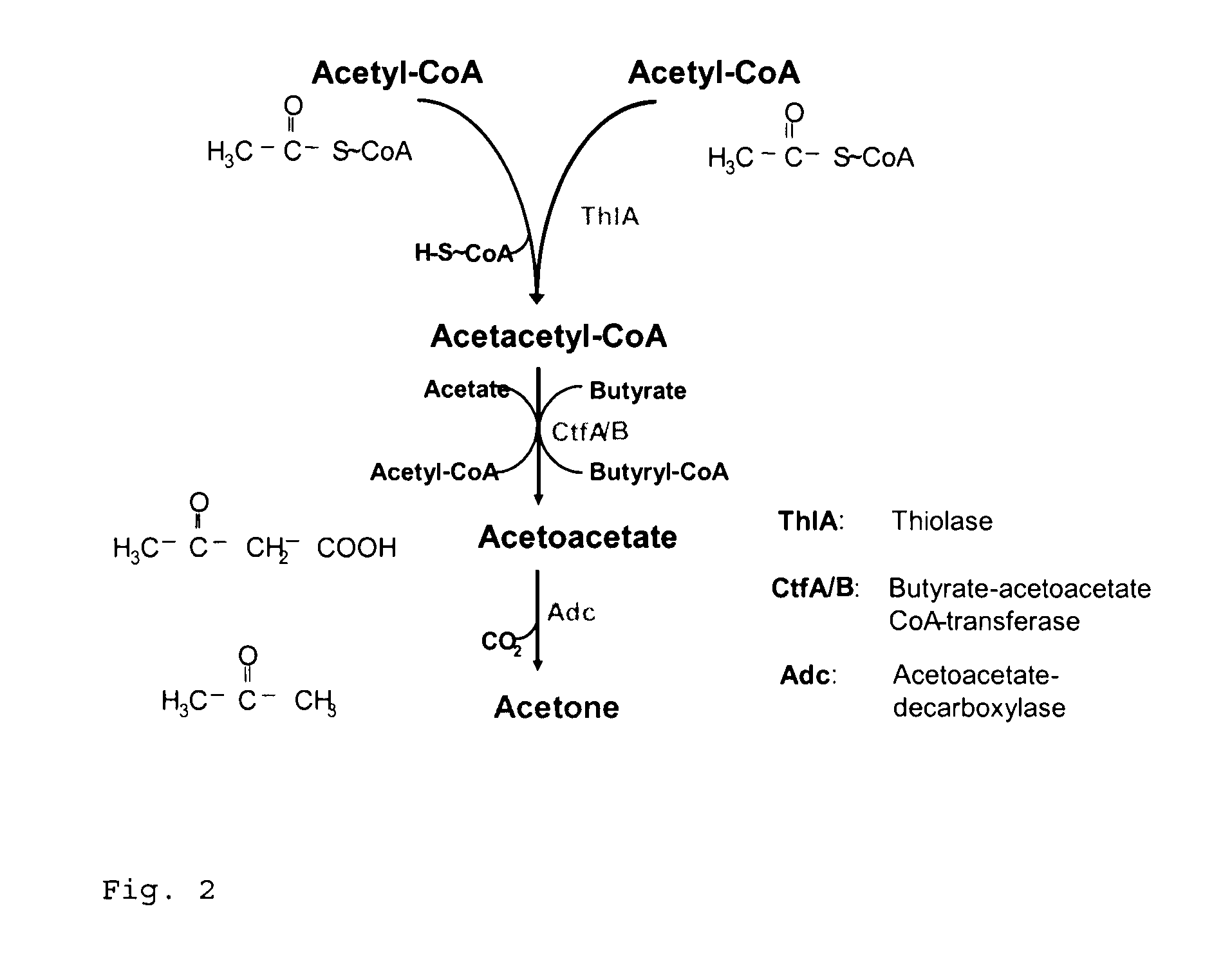Cells and method for producing acetone
- Summary
- Abstract
- Description
- Claims
- Application Information
AI Technical Summary
Benefits of technology
Problems solved by technology
Method used
Image
Examples
example 1
Cloning of the Expression Vectors
[0078]For acetone production in acetogenic cells, clonings into E. coli XL2 blue were carried out. For this, the genes
ctfA and ctfB from Clostridium acetobutylicum,
or atoA and atoD from E. coli,
or teII from B. subtilis,
and / or ybgC from Haemophilus influenzae
together with the genes thlA and adc from C. acetobutylicum were arranged on the plasmid pIMP1 (Mermelstein et al., 1992).
[0079]An overview of the corresponding expression plasmids is presented in Table 1.
TABLE 1PlasmidsCoA-transferase / thioesterasePlasmidfromSeq ID NopIMP_adc_ctfAB_thlAC. acetobutylicum13pIMP_adc_atoDA_thlAE. coli14pIMP_adc_teII_thlAB. subtilis15pIMP_adc_ybgC_thlAH. influenzae16
[0080]The genes were cloned sequentially. For this, firstly oligonucleotides (Table 2) were designed for amplification of the genes, introducing corresponding cleavage sites, and then all fragments were amplified.
TABLE 1OligonucleotidesCleavageNameSequence (5′→ 3′) *)siteSeq ID Noadc fwGGAAGGTACCTTTTATG...
example 2
Acetone Synthesis in E. coli
[0087]To check for functionality, all plasmid variants obtained (see Table 1) were investigated for acetone formation in the E. coli cloning strain XL2-blue. The analyses were performed at the 100-ml scale in TY medium with ampicillin (100 μg / ml). After inoculation from corresponding precultures to an optical density (600 nm) of 0.1, incubation was carried out at 37° C. and 150 rpm. The optical density was monitored photometrically and at specified timepoints, over a period of approx. 50 h, samples were taken and the concentration of acetone and acetate in the cell-free supernatant was determined by gas chromatography. It was found that with the combination of clostridial genes (thlA and adc) with atoDA from E. coli, up to 80 mM acetone was produced. With purely clostridial genes (thlA, ctfAB, adc), 5 mM acetone was produced, and with the combinations of clostridial genes (thlA and adc) with tell from B. subtilis or ybgC from H. influenzae, 1 mM acetone ...
example 3
Acetogenic Acetone Production
[0088]Different media were used, depending on the Clostridia strain employed:
[0089]For preparation of the media for C. carboxidivorans or C. ljungdahlii, the chemicals were weighed, dissolved in water and then the pH was adjusted. In addition, the redox indicator reszurin (1 mg / l) was added, to permit later testing of the redox potential and therefore of the oxygen content. Then the media were brought to the boil in a heating mantle and cooled in an ice bath. During this, gassing was carried out with nitrogen, to remove the dissolved oxygen. Then the media were transferred into the anaerobic chamber, the final volume was adjusted with anaerobic water, it was filled and sealed hermetically. If a gas phase other than nitrogen was to be used, gas exchange was carried out, wherein the medium was gassed with the corresponding gas by means of a long cannula and finally a slight excess pressure of approx. 0.8 bar was applied.
[0090]For the medium for C. aceticum...
PUM
| Property | Measurement | Unit |
|---|---|---|
| Volume | aaaaa | aaaaa |
| Volume | aaaaa | aaaaa |
| Mass | aaaaa | aaaaa |
Abstract
Description
Claims
Application Information
 Login to View More
Login to View More - R&D
- Intellectual Property
- Life Sciences
- Materials
- Tech Scout
- Unparalleled Data Quality
- Higher Quality Content
- 60% Fewer Hallucinations
Browse by: Latest US Patents, China's latest patents, Technical Efficacy Thesaurus, Application Domain, Technology Topic, Popular Technical Reports.
© 2025 PatSnap. All rights reserved.Legal|Privacy policy|Modern Slavery Act Transparency Statement|Sitemap|About US| Contact US: help@patsnap.com



